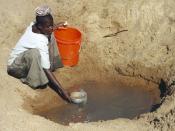According to the World Wildlife Fund (WWF, 2014), freshwater can be defined as water with less than 0.5 parts per thousand of dissolved salts. Less than three percent of Earth's water is fresh water (Shiklomanov, 1993); most of that three percent is inaccessible (United States Geological Survey [USGS], 2014). Approximately 68 percent of the fresh water on Earth is found in icecaps and glaciers, and over 30 percent is found in groundwater (Shiklomanov & Sokolov, 1983). Only about 0.3 percent of our fresh water is found in the surface water of lakes, rivers, and swamps (Shiklomanov, 1993). This fresh water amounting to about 0.3 percent is actually the main source for the world's daily water consumption.
According to the History of Water Filters (2010), the water that is used for daily consumption actually comes from two major freshwater resources, the groundwater system and surface water system. Surface water refers to waters, which are open to the atmosphere and are subject to surface runoff (USGS, 2014).
Surface water is also defined as water that flows in streams and rivers and in natural lakes, in wetlands, and in reservoirs constructed by humans (Shiklomanov, 1993). Another resource of freshwater is the groundwater, which is the water located beneath the earth's surface in soil pore spaces and in the fractures of rock formations (Nelson, 2012). Groundwater is actually surface water that has migrated from the surface through the ground and become stored in porous soils and rocks (United States Environment Protection Agency [USEPA], 1991). Groundwater constitutes about 30 percent of the world's total freshwater (Shiklomanov & Sokolov, 1983).
Over 1.1 billion people worldwide lack access to safe drinking water (World Health Organization [WHO], 2014). In Asia alone, inadequate water supply and poor sanitation cause more than 500,000 infant deaths a year...


